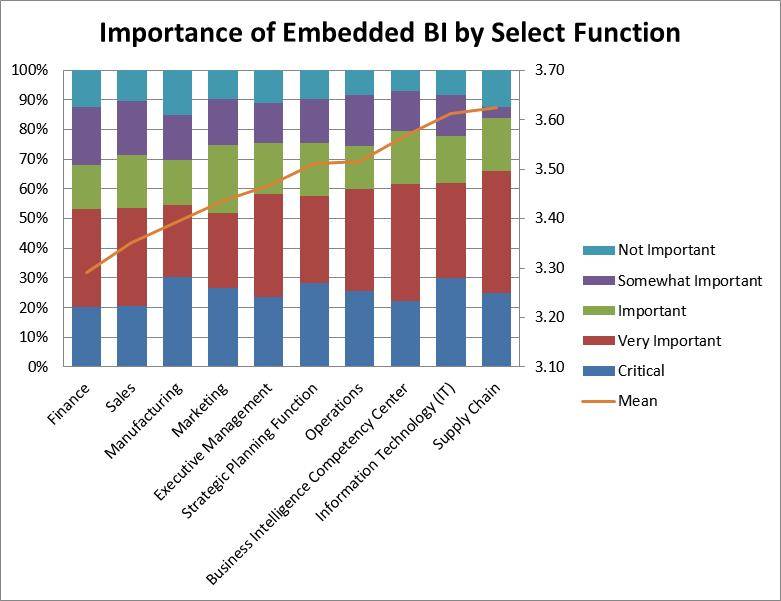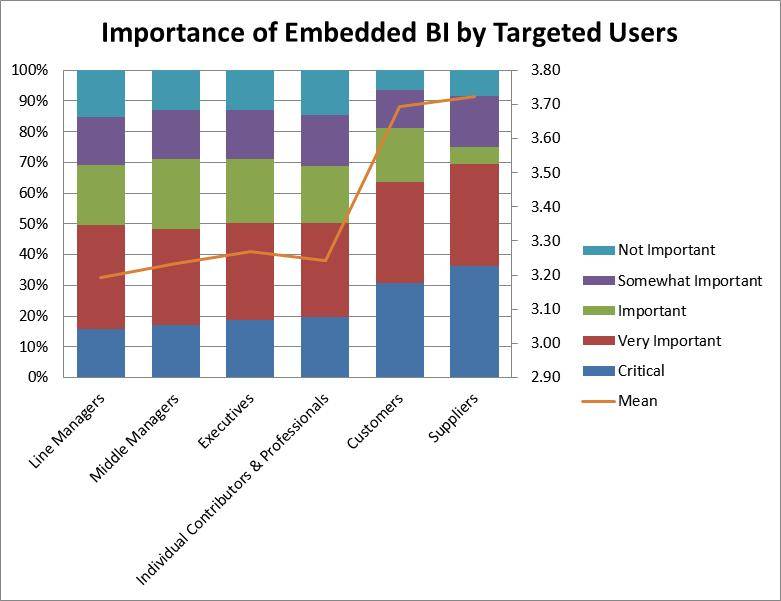In our agenda for studying the evolving use of BI technologies through our flagship Wisdom of Crowds® Market Business Intelligence Study, we added a survey component this year on the embedded BI aspect. Until this study, embedded BI had not been fully explored in the advisory space. We knew from conversations we have on an ongoing basis with folks in the BI industry that it is an important aspect, and our 2013 Wisdom of Crowds® Embedded Business Intelligence Market Study revealed that to be true. More than 50 percent of the 1,182 survey participants ranked embedded BI as “critical” or “very important.”
Although our annual flagship study shows BI penetration in 2013 is less than 10 percent of user populations in most organizations, the goal for business intelligence has always been to make it pervasive within organizations. Our embedded BI study found that when organizations are successful with business intelligence in general, the more prone they are to use embedded BI functionalities. We found this same phenomenon in our 2013 Wisdom of Crowds® Cloud Business Intelligence Market Study. Once they reach a certain point in progression and success with BI, organizations try to figure out how to achieve even greater results and amplify their success.
So how do they accomplish that? Do they arm everybody with a copy of the favorite tool? Probably not. The way to deliver actionable insight to more users is to include it in the context of something else that they do more often than not. For instance, it could be embedded in an ERP or CRM application, embedded in a Web portal, or served through the public cloud or to mobile devices.
How companies are using embedded BI to create competitive advantages
In our study, participants in back-office functions rated the importance of embedded BI higher than front-office folks.
Figure 1

© 2013. Dresner Advisory Services
But despite the fact that back-office departments are operationally focused, their keen interest in embedded BI is not focused on saving money. They are using it for strategic purposes, embedding BI to deliver content to external constituents such as customers and suppliers and create Internet-centric competitive advantages with these existing relationships.
Figure 2

© 2013. Dresner Advisory Services
One of the interesting challenges that exists certainly within large organizations is ensuring that suppliers become and stay aligned with the needs of the enterprise.
With embedded BI in a supplier Web portal, for instance, an organization can provide insights surrounding inventory, raw materials, etc. to help suppliers understand customer trends and how they might help the organization achieve even more value. Similarly, embedded BI can show customers who is consuming the organization’s products and services, thus helping the customer plan better and more accurately predict its demand for the products or services. Embedded BI can facilitate seamless orders and other data transactions.
The primary objectives, as revealed in our embedded BI study, are increased competitive advantage, enhanced customer service and growth in revenue. So it’s not really about improving operational efficiency or arguably even better decision making. Organizations embed the BI information as a way of aligning external constituents with the organization’s strategy.
I believe there also may be a correlation with cloud. Our 2013 cloud study found that customers and suppliers were among the top targets of cloud BI information. It may be a bit of a leap at this point in time to consider embedded BI in a portal in the public cloud. But that would be a strategy for isolating content and information to customers and suppliers, delivering it to them without letting them into the organization’s internal systems.
Recent adopters
The study found that recent adopters of business intelligence tools and technologies also place a higher priority on embedded BI. While there may be a number of explanations for this finding, our assumption is that recent adopters (less than one to two years) are more open to newer technologies and have a less rigid view of approaches to BI deployment.
Which geographies rank embedded BI as important?
More participants in the EMEA region ranked embedded BI as “not important” than participants in any other region. (Survey participants were segmented geographically as follows: 59 percent of participants were from North America, 25 percent represented 35 countries in EMEA, 11 percent represented 15 countries in APAC and four percent were from Latin America.) This makes sense as typically EMEA is slower to shift to newer technologies.
Mobile impact on embedded BI
The initiatives and BI technologies that our study’s participants indicated they are most excited about are dashboards, cloud and mobile.
I think that embedding BI in mobile apps has merit, but I don’t think mobile will become the largest percentage of consumption for embedded BI. My sense is that embedded BI in a mobile device would be useful mostly when a user is doing something strategic and urgently needs the latest and greatest information, before stepping into a meeting, for example. Given this scenario, delivering embedded BI to external constituents — the highest priority today for creating a competitive advantage — is probably less of a priority on mobile.
Vendors’ approach to embedded BI architecture
Our study found that 51 percent of vendors ranked embedded BI as “critically important.” Not a surprise, given that they try to stay in tune with their customers’ needs.
What surprised me was how many vendors have reasonable support capabilities for embedded BI technologies at this point. Our study shows that most BI vendors can provide and support the basic architecture that the consumers of the technology care about today.
BI users in our study ranked basic architecture highest — embed it into an HTML/iframe or use Web services or a RESTful interface, for example — something modern, Web-centered and simple just to get it up and running rather than traditional approaches of integrating it and compiling it into existing code. More programmatic approaches requiring development resources (Java API, for example) or widgets and gadgets ranked lower in preference. However, government participants ranked JavaScript as a higher priority.
Most of the vendors support iframes and RESTful, but support trails off after these approaches. If they can just get away with doing a relatively simple integration or a simple API that is broadly applicable, that’s a win-win. It’s more appealing to potential customers and also easier to implement and maintain as opposed to having to embrace Microsoft’s or Oracle’s platform, which requires expertise. It’s more costly and more complex to do that level of integration, especially if it’s not a mainstream approach.
Today the mainstream approaches are Web-centric (and by extension, mobile); that is where people want to integrate technologies instead of doing it on a desktop. The greater ease of integration using RESTful and iframes makes creating a mashup between applications far easier than before. This is influencing the growth of embedded BI.
Among our first set of embedded BI benchmarks revealed in this study is the finding that industry support is well aligned with user requirements. Of 21 BI vendors our study asked participants to rank for satisfaction with their embedded BI capabilities and architecture, 11 vendors scored 80 percent or higher. Priorities of users and vendors for embedded BI architecture are unusually well aligned and thus remove what might otherwise have been a significant barrier. We look for this to help facilitate the proliferation of embedded business intelligence capabilities more quickly.
The report on the 2013 Wisdom of Crowds® Embedded Business Intelligence Market Study is available at www.embeddedbireport.com. The report includes a Buyer’s Guide for embedded BI; a Buyer’s Guide for embedded capabilities; user feature requirements; vendor ratings; target applications for embedded BI by function and organization size; prioritized integration resources by function, industry, organization size and geography; the importance of embedded BI by industry, function, geography and organization size; and more.
The Wisdom of Crowds ® Embedded Business Intelligence Market Study was conceived and executed by Dresner Advisory Services, LLC, an independent advisory firm, and Howard Dresner, its president, founder and chief research officer. Howard Dresner is one of the foremost thought leaders in Business Intelligence and Performance Management, having coined the term “Business Intelligence” in 1989. He has published two books on the subject, The Performance Management Revolution — “Business Results through Insight and Action”, and “Profiles in Performance — Business Intelligence Journeys and the Roadmap for Change.” Prior to Dresner Advisory Services, Howard served as chief strategy officer at Hyperion Solutions and was a research fellow at Gartner, where he led its Business Intelligence research practice for 13 years.
